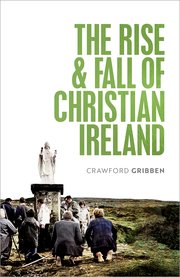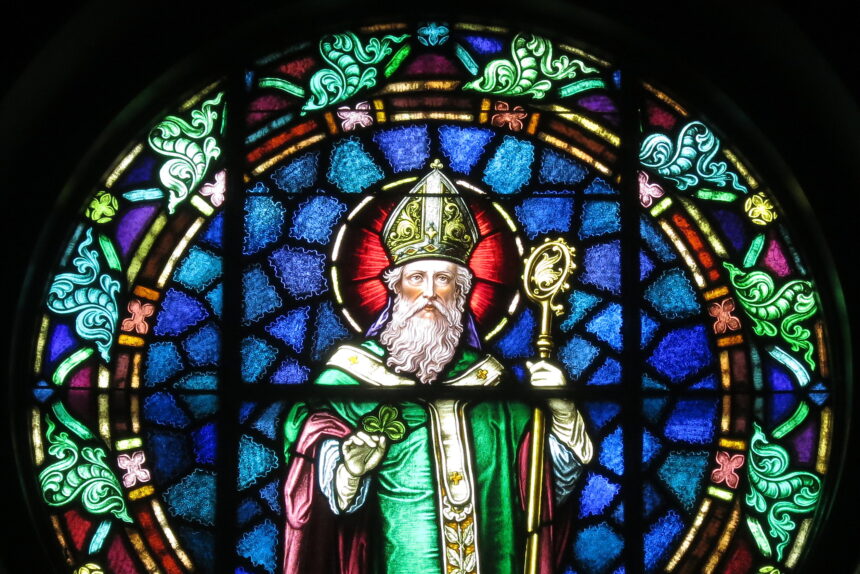
The Rise and Fall of Christian Ireland
by Crawford Gribben
Oxford University Press
352 pp., $32.95
Crawford Gribben has produced a fascinating history of Christian Ireland from its promising beginnings, in the age following the fall of the Roman Empire, to its dramatic decline in recent decades. The author is not, as one might expect, a Catholic, but he grew up in County Antrim in Northern Ireland in a small sect known as the Plymouth Brethren. As a result, the book pays considerable attention to the history of Ireland’s more obscure Protestant communities. On the other hand, the book also gives ample attention to Ireland’s pre-Reformation era.
The beginnings of Christianity in Ireland mark the beginning of the country’s documented history. Christianity arrived in the fifth century, more than 100 years before it came to what is now England and centuries before the rest of Northern Europe. St. Patrick is frequently represented as the first Christian in Ireland, though it now appears that St. Palladius, appointed a bishop by Pope Celestine and sent to Ireland in 431, predates St. Patrick.
The centuries following the country’s evangelization have become known as Ireland’s Golden Age. Irish missionaries such as St. Columba and St. Aidan evangelized Scotland and the north of England. St. Columbanus established monasteries in Frankish and Lombardic regions, and Ireland’s scholarly institutions attracted international students. Frankish bishops were trained in Irish monasteries, and Irish scholars taught in the schools of Charlemagne’s empire. Irish monasteries were established in regions as far as Iceland. By the ninth century, monks were writing in the Irish vernacular.
Gribben writes:
The achievements of the Irish church in the early Christian period were extraordinary, so that those nativist nationalists who, many centuries later, remembered this as a time when Ireland was the “literary centre of Christendom” were not far off the mark.
Perhaps the most important event in Irish history is what is known as the “English invasion,” beginning in 1169, which began the long association of Ireland with England, lasting into the 20th century and persisting still in the North. However, to describe the invasion as “English” is not entirely correct. The leaders of the invasion were Norman barons, and their soldiers largely Welsh, and in Gribben’s words,
they arrived at the request of an Irish ruler, with the support of a Plantagenet king, the permission of the pope, and as the harbinger of a larger force that would be drawn from across the Angevin empire.
The pretext for invasion was the 1155 papal bull, Laudabiliter (the authenticity of which has been disputed), wherein the pope authorized the king of England to sort out the problems of the Irish church. This meant implementing the reforms of Pope Gregory VII (1073-1085), which apparently had never taken root in Ireland. Much has been written about the corruption and backwardness of the Irish church prior to the English arrival. Gribben, however, disputes that characterization:
Since their foundation, the Irish monasteries had sustained a vigorous intellectual culture, and continued to promote educational excellence … Monks worked hard to establish how best to read the biblical text, while paying attention to progressive revelation in the history of redemption … Alongside these developments in biblical theology, monks continued to preserve key texts from the ancient world, so that Irish adaptations of classical myths were among the earliest in Europe.
Early colonists from England tended to become gaelicized, adopting Irish customs and often the Irish language. The Reformation, however, created a new and distinct class in Ireland, separate from the mass of Irish who remained Catholic. Gribben describes how, in the early 17th century, the Irish population could be divided into four groups:
The native Irish were the descendants of the island’s indigenous inhabitants, Catholic in religion, and Gaelic-speaking … The “Old English” were the descendants of the Anglo-Norman settlers, Catholic in religion, with bilingual facility in English and Irish … “New English” planters … promoted a vigorous Protestantism, and a vigorous hostility to Irish language and culture … Finally, the Ulster Scots, who were concentrated in the north-east after the 1610s, and spoke a language closely related to English, were Presbyterian.
Gribben notes what he sees as some interesting ironies relating to the religious divide in Irish history. Of the 1688 Revolution and the subsequent conflict between Catholic James II and Protestant William III, he writes:
James was neither a constitutional revolutionary nor a supporter of Irish independence … Neither, despite his well-known zeal as a relatively recent convert, was James any kind of religious bigot. Irish dissenters had a great deal to gain from his policy of religious toleration. …By the same token, there was every reason for Catholics to support William. After all, the Prince of Orange had received the blessing of the pope, largely because his efforts to resist James coincided with the Vatican’s efforts to stymie the strategy of James’s ally, Louis XIV of France, who was attempting to make the French church independent of Rome.
The Revolution of 1688 led to more than a century of penal laws targeted at the Catholic majority, but according to Gribben the motive for these laws was not primarily religious but economic:
Despite their sectarian character, the penal laws were designed to uphold the privileges of the minority of Anglicans and were not intended to persuade members of other denominations to convert. … The penal laws appeared to police religious difference, but they worked to protect the interests of a social and economic elite, even as a new Catholic middle class began to consolidate around interests in trade.
Between the 18th and 20th centuries, the political allegiances of Catholics and Protestants would shift dramatically. Irish nationalism began as a largely Protestant-led movement. Many Ulster Scots supported the American Revolution, which one observer called a Scotch-Irish-Presbyterian rebellion. The American victory at Bunker Hill was celebrated with bonfires on the hills of Antrim, and the Belfast Newsletter was the first European newspaper to publish the Declaration of Independence.
Irish Catholic bishops, on the other hand, encouraged loyalty to the Crown. Many Catholics supported the 1800 Act of Union, which brought Ireland under the Westminster Parliament, because they felt it would lead to better treatment of Catholics, while many Protestants considered unification a Catholic plot and preached against it in “apocalyptic tones.”
But by the end of the 19th century, allegiances had radically shifted. Following Catholic Emancipation, Irish Catholics could now obtain political power and a large majority, and therefore came to favor self-government. Protestants came to fear that home rule would mean “Rome rule” and became champions of the union with Britain.
When Ireland finally became independent, it would be a strongly Catholic state but one in which the Protestant minority would have considerable representation in banking, the legal profession, and sections of the media—as well as in the Irish Senate.
The Catholic Church, of course, held a powerful position in the Irish Republic. As late as the 1980s, a large majority of the Irish voted in referendums to uphold Catholic positions on divorce and abortion, but this resistance would begin to collapse in the 1990s. Widespread revelations of clerical sexual abuse destroyed what remained of the Church’s credibility, and in 2011, the country symbolically closed its embassy in the Vatican.
The most recent survey of religious attitudes took place in 2016 and showed decline in both Catholic and Protestant religious belief but a rise in the number of Orthodox believers, largely due to East European immigration. While 78 percent of the population still described themselves as Catholic, this did not translate into support for Catholic moral teachings, as evidenced by the large majority votes for abortion and same-sex marriage in national referendums. As is the case elsewhere in the West, Ireland has seen Christianity replaced by a secular materialist, leftist ideology and the Church by a woke and unaccountable financial elite.
While Gribben describes this book as “a labour of love for the religious world in which I was formed,” he appears to have no love for the Christian state. “What passed as Christian Ireland is finally over—and Christians should be glad,” he says. Although he expresses serious concern about the decline of Christian faith and morals in Ireland and the corresponding rise of the new secular elite, he expects Christians in Ireland to once again provide salt and light to a dark age.

Leave a Reply